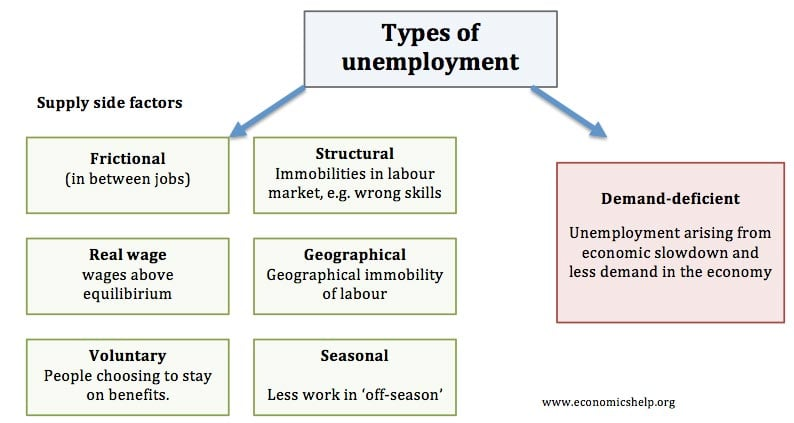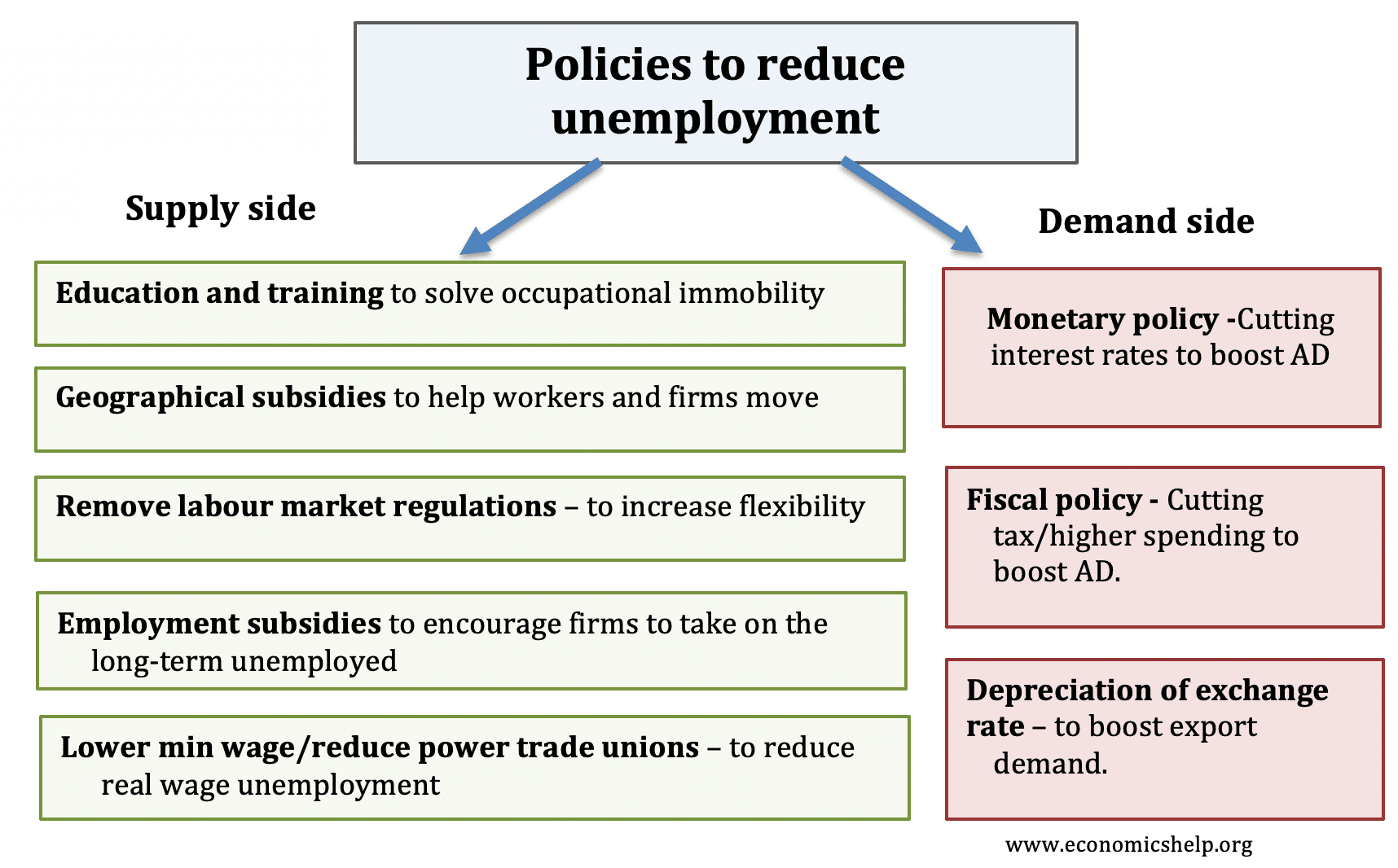AQA Specification focus:
‘Students should appreciate that unemployment has a variety of causes and hence the appropriate policies to reduce unemployment depend on the cause.’
Introduction
Understanding how to reduce unemployment effectively requires identifying its specific cause. Each type of unemployment responds differently to policy, meaning one-size-fits-all approaches are often ineffective.
Linking Causes to Policies
Unemployment can arise from demand-side factors, where insufficient aggregate demand reduces job opportunities, or supply-side factors, where structural issues prevent workers from filling available roles. Recognising the source is crucial for applying the right solution.

This diagram categorises the main types of unemployment—frictional, structural, real wage, seasonal, and cyclical—highlighting their causes and characteristics. It aids in identifying appropriate policy responses by distinguishing between demand-side and supply-side unemployment. Source
Demand-Side Causes and Policies
When unemployment stems from inadequate demand for goods and services, the government may employ policies that stimulate aggregate demand (AD).
Expansionary fiscal policy: Increasing government spending or cutting taxes raises AD, encouraging firms to hire more workers.
Expansionary monetary policy: Lowering interest rates reduces borrowing costs and stimulates investment and consumption, boosting job creation.
Demand-deficient (cyclical) unemployment: Joblessness caused by a lack of aggregate demand in the economy, typically during a recession.
By raising demand, these policies directly increase the demand for labour, thereby reducing cyclical unemployment.
Supply-Side Causes and Policies
Supply-side unemployment arises when issues exist in the labour market itself, regardless of demand levels. Policies must address barriers to employment.
Education and training programmes: Equipping workers with new skills reduces structural unemployment caused by technological change or globalisation.
Geographical mobility improvements: Investment in transport links and relocation support helps workers move to where jobs exist.
Reducing welfare dependency: Adjusting benefits to encourage job-seeking can reduce voluntary unemployment.
Labour market deregulation: Lowering barriers such as strict employment protection legislation can encourage firms to hire.
Structural unemployment: Unemployment resulting from a mismatch between workers’ skills or location and the requirements of available jobs.
Voluntary vs Involuntary Unemployment
It is important to distinguish between voluntary and involuntary unemployment. Policies must reflect whether workers are unwilling to work at prevailing wage rates or unable to find employment despite wanting it.
Voluntary unemployment may be reduced by incentives such as tax credits.
Involuntary unemployment typically requires demand stimulation or targeted supply-side reforms.
Voluntary unemployment: When individuals choose not to work at the current wage rate.
Real-Wage Unemployment and Policy
Sometimes unemployment persists because real wages are set above the equilibrium level, reducing demand for labour. This is often due to trade union bargaining power or minimum wage laws.
Policies include:
Moderating minimum wage growth to balance worker protection with labour demand.
Encouraging flexible wage bargaining systems.
Real-wage unemployment: Unemployment caused when wages are maintained above the market-clearing level, reducing the quantity of labour demanded.
Cyclical Unemployment and Output Gaps
A negative output gap (when actual GDP is below potential GDP) leads to higher cyclical unemployment. Policies here often centre on boosting demand.
Fiscal stimulus measures can close output gaps.
Monetary easing ensures liquidity in the economy.
Output gap: The difference between actual GDP and potential GDP.
Recognising whether the gap is positive or negative helps determine if policies should stimulate or cool demand.

This image outlines various policy responses to unemployment, categorising them into demand-side and supply-side policies. It illustrates how different types of unemployment require tailored policy interventions. Source
Matching Policy Tools to Unemployment Types
For clarity, the major types of unemployment and their corresponding policies include:
Cyclical unemployment (demand-deficient):
Expansionary fiscal policy
Expansionary monetary policy
Structural unemployment:
Training and retraining programmes
Improved mobility policies
Apprenticeships and lifelong learning
Seasonal unemployment:
Encouraging off-season industries (e.g., tourism support in off-peak periods)
Retraining for alternative seasonal jobs
Frictional unemployment (time between jobs):
Enhanced job information services
Digital job-matching platforms
Real-wage unemployment:
Flexible labour market policies
Wage moderation
Each policy directly aligns with a cause, ensuring effective use of limited resources.
Policy Mix and Evaluation
Governments rarely rely on a single policy. A policy mix ensures that both short-term demand issues and long-term structural challenges are addressed. For example:
Using short-run demand management to reduce cyclical unemployment during a downturn.
Combining this with long-run supply-side policies such as education reform to improve resilience.
Effective unemployment policy requires recognising the interaction of multiple causes and the need for tailored responses.
FAQ
A single policy may fail because unemployment often has multiple overlapping causes. For example, demand may be low while structural skill shortages also exist.
Effective reduction usually requires a combination of demand-side and supply-side policies. This ensures that both short-term and long-term problems are addressed simultaneously.
Policymakers look at economic indicators such as GDP growth, inflation, and labour market surveys.
If demand is weak, they lean towards fiscal or monetary expansion.
If structural mismatches exist, such as skills gaps, they use training or education reforms.
Yes. Expansionary fiscal policy may reduce unemployment but also increase inflation or government debt.
Supply-side reforms may take years to have an impact, and deregulation could lower job security for workers. Policymakers must weigh these trade-offs.
Frictional unemployment is natural and short-term, arising as workers move between jobs. It signals a dynamic labour market where people seek better matches.
Policies usually focus on reducing excessive delays through job centres or online platforms, but eliminating frictional unemployment entirely is neither possible nor desirable.
If minimum wages are set too high, they may contribute to real-wage unemployment. In such cases, wage flexibility policies may be suggested.
However, minimum wages can also increase labour participation and reduce poverty. Policymakers must balance protecting workers with ensuring firms continue to hire.
Practice Questions
Define cyclical unemployment and identify one policy that could reduce it. (2 marks)
1 mark for a correct definition of cyclical unemployment: unemployment caused by insufficient aggregate demand in the economy, usually during a recession.
1 mark for correctly identifying a policy, e.g. expansionary fiscal policy or expansionary monetary policy.
Explain why it is important to match the policy used to the specific cause of unemployment. (6 marks)
Up to 2 marks for recognising that different types of unemployment have different causes (demand-side vs supply-side).
Up to 2 marks for explaining that demand-side policies (e.g. increasing government spending, lowering interest rates) are suitable for cyclical unemployment but ineffective for structural unemployment.
Up to 2 marks for explaining that supply-side policies (e.g. training programmes, mobility improvements) are suitable for structural unemployment but may not reduce cyclical unemployment.
Award full marks for clear, precise explanation and explicit linking of causes of unemployment to appropriate policies.

